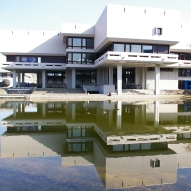Zusammenfassung
The initial adhesion of microorganisms to clin. used dental biomaterials is influenced by physico-chem. parameters like hydrophobicity and pre-adsorption of salivary proteins. Here, polymethyl methacrylate (PMMA), polyethylene (PE), polytetrafluoroethylene (PTFE), silicone (Mucopren soft), silorane-based (Filtek Silorane) and methacrylate-based (Tetric EvoCeram) dental composites, a conventional ...
Zusammenfassung
The initial adhesion of microorganisms to clin. used dental biomaterials is influenced by physico-chem. parameters like hydrophobicity and pre-adsorption of salivary proteins. Here, polymethyl methacrylate (PMMA), polyethylene (PE), polytetrafluoroethylene (PTFE), silicone (Mucopren soft), silorane-based (Filtek Silorane) and methacrylate-based (Tetric EvoCeram) dental composites, a conventional glassionomer cement as well as cobalt-chromium-molybdenum (Co28Cr6Mo) and titanium (Ti6Al4V) were tested for adsorption of salivary proteins and adhesion of Streptococcus gordonii DL1. Wettability of material surfaces precoated with salivary proteins or left in phosphate-buffered saline was detd. by the measurement of water contact angles. Amts. of adsorbed proteins were detd. directly on material surfaces after biotinylation of amino groups and detection by horseradish peroxidase-conjugated avidin-D. The same technique was used to analyze for the binding of biotinylated bacteria to material surfaces.The highest amt. of proteins (0.18 μg/cm2) adsorbed to hydrophobic PTFE samples, and the lowest amt. (0.025 μg/cm2) was detected on silicone. The highest no. of S. gordonii (3.2 × 104 CFU/mm2) adhered to the hydrophilic glassionomer cement surface coated with salivary proteins, and the lowest no. (4 × 103 CFU/mm2) was found on the hydrophobic silorane-based composite. Hydrophobicity of pure material surfaces and the no. of attached microorganisms were weakly neg. correlated. No such correlation between hydrophobicity and the no. of bacteria was detected when surfaces were coated with salivary proteins.Functional groups added by the adsorption of specific salivary proteins to material surfaces are more relevant for initial bacterial adhesion than hydrophobicity as a phys. property. [on SciFinder(




 Altmetric
Altmetric